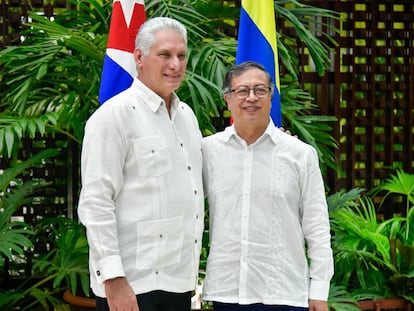Ceasefire between Colombian government and the ELN comes into force
After eight months of talks, an unprecedented bilateral ceasefire has finally been agreed with the guerrilla group, which has been active since the 1960s

Over the last 30 years, seven Colombian presidents have attempted to hold talks with the National Liberation Army (ELN) guerrillas. For the first time in its almost 60-year history, the ELN has agreed to a ceasefire, which will be bilateral and will last, initially, until January 29, 2024. To commemorate the event, a ceremony will be held Thursday and attended by President Gustavo Petro and ELN delegates including Aureliano Carbonell, Pablo Beltrán and Bernardo Téllez. The event will also mark the beginning of the so-called Participation Agreement, signed by the parties at the negotiating table.
The inauguration of the National Participation Committee (CNP) is a remarkable step in terms of organizing the participation of civil society, a traditional claim of the ELN, which sees itself not as an army but more of an armed wing of the people. Thursday’s event is expected to be attended by more than 80 delegates from 30 different social sectors, who will form part of the CPN together with members of the ELN and government negotiating teams. Most of these delegates are members of ethnic, trade union and business organizations. Consuelo Tapias, Mauricio Iguarán, Claudia Rodríguez and Juan Carlos Cuéllar were appointed by the ELN.
The idea is that the committee will gather proposals from communities throughout the country on the changes they believe necessary for peace, as a sort of social input for the negotiation. To achieve this, the CNP will initially design the instruments for the inclusion of citizens through nine regional and 15 local meetings, in a period of between four and six months. This will be followed by a phase in which all the members of the committee will discuss the proposals and formulate concrete policies and projects to be discussed with the negotiating teams, with a view to jointly building a territorial peace.
In addition to the CNP, this Thursday the Monitoring and Verification Mechanism (MVM) will come into force to oversee compliance with the ceasefire. It will issue monthly reports to help the parties decide whether to extend or suspend the truce. The mechanism will be composed of General Gerardo Benavides, head of the Joint Transition Command, and Colonel Lurangeli Franco; delegates from the Office of the High Commissioner for Peace; ELN leaders, including Bernardo Téllez and Gustavo Martínez; members the Episcopal Conference, and officials from the United Nations Verification Mission in Colombia. As well as the national MVM, there will be nine regional and 22 local mechanisms, which will each contain at least two ELN members to maintain communication with the armed structures in each area.
The task of protecting those who make up the MVMs will be mainly in the hands of the Police Unit for Peacebuilding (UNIPEP), which was created during the peace agreement signed with the FARC in 2016. UNIPEP has been training in recent weeks for the task under the guidance of the United States Institute of Peace.
A fragile hope
For some social leaders in areas hard hit by violence, such as the department of Chocó, where the ELN’s Omar Gómez Western War Front operates, the ceasefire opens a door of hope. However, distrust is still latent in the region, especially after the humanitarian crisis caused by the armed strike imposed by the ELN for 15 days at the beginning of July. Added to this is the fear among communities due to the constant clashes between the ELN and other illegal armed groups such as the Clan del Golfo (Gulf Clan) or the FARC dissidents known as the Estado Mayor Central (Central General Staff).
“We are not so hopeful about what is being promised because history has taught us otherwise,” says a leading member of the Human Rights Network of the Pacific, who asks for his identity to be withheld to avoid putting his life at risk. For this leader, the ceasefire will not have a significant impact in Chocó if it is not implemented in parallel with other armed groups. “Here we see the dialogues with the ELN as the negotiation of a single group, when what we need is for all the armed actors operating in our territory to enter into a consensus.” Francisco Daza, coordinator of the Peace and Reconciliation Foundation (PARES) agrees: “It has been proven that the bulk of armed actions do not take place between illegal groups and the security forces, but among themselves. So that is the challenge: for the government to achieve a de-escalation of violent actions among illegal armed groups. The ceasefire is a partial solution, but it is not the recipe to guarantee humanitarian relief for the civilian population.”
Sign up for our weekly newsletter to get more English-language news coverage from EL PAÍS USA Edition
Tu suscripción se está usando en otro dispositivo
¿Quieres añadir otro usuario a tu suscripción?
Si continúas leyendo en este dispositivo, no se podrá leer en el otro.
FlechaTu suscripción se está usando en otro dispositivo y solo puedes acceder a EL PAÍS desde un dispositivo a la vez.
Si quieres compartir tu cuenta, cambia tu suscripción a la modalidad Premium, así podrás añadir otro usuario. Cada uno accederá con su propia cuenta de email, lo que os permitirá personalizar vuestra experiencia en EL PAÍS.
¿Tienes una suscripción de empresa? Accede aquí para contratar más cuentas.
En el caso de no saber quién está usando tu cuenta, te recomendamos cambiar tu contraseña aquí.
Si decides continuar compartiendo tu cuenta, este mensaje se mostrará en tu dispositivo y en el de la otra persona que está usando tu cuenta de forma indefinida, afectando a tu experiencia de lectura. Puedes consultar aquí los términos y condiciones de la suscripción digital.
More information
Archived In
Últimas noticias
Most viewed
- Sinaloa Cartel war is taking its toll on Los Chapitos
- Oona Chaplin: ‘I told James Cameron that I was living in a treehouse and starting a permaculture project with a friend’
- Reinhard Genzel, Nobel laureate in physics: ‘One-minute videos will never give you the truth’
- Why the price of coffee has skyrocketed: from Brazilian plantations to specialty coffee houses
- Silver prices are going crazy: This is what’s fueling the rally











































